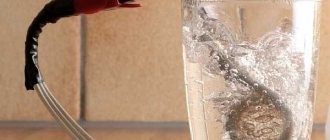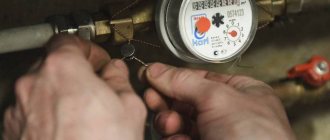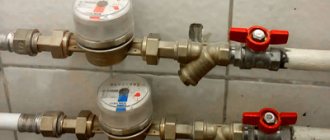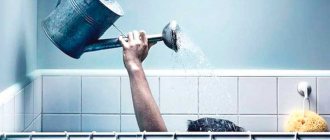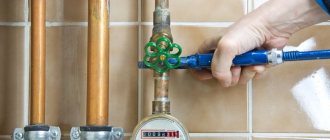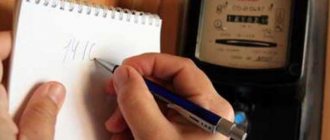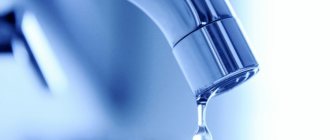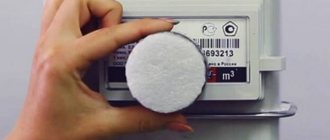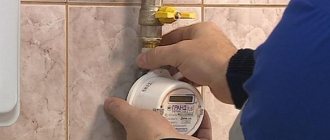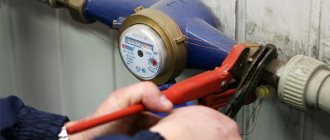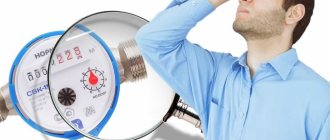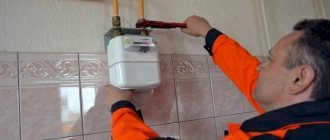The constant increase in tariffs for hot and cold water supply, as well as the adoption of a law on the mandatory installation of water meters in an apartment or house, is nothing more than a desire to save, unfortunately, the exhaustible resources of our planet. Moreover, in Europe they have long and confidently used a similar method with concern for the environment.
In Russia, consumption of hot and cold water in large volumes without significant savings is considered the norm. Especially in cases where users have a solid financial foundation and can afford the luxury of high water consumption per month.
However, the opposite situation also happens. The meters are installed, I don’t mind saving on water supply, but for some reason, when readings are taken, it turns out that the consumption of both cold and hot water turned out to be more than prescribed in the average standards per person.
Why this happens, how to solve issues with meters and water savings per month, we will understand in our material.
Can a water meter give incorrect data?
The problem of the device winding up unnecessary water consumption readings is real.
Even with economical use of the resource, the meter may show two or three times the actual water consumption.
The problem may be associated either with an increase in resource consumption that is invisible to the consumer, or with a malfunction of the water meter itself.
Attention! Flow meters can record readings with a small error. But normally it should not exceed 5%. If this value is greater than the norm, then the water consumption will become noticeably greater than the actual one.
What is ODN
ODN - general house needs, consumption of resources (water, electricity, heat) in the premises of the house that are not parts of apartments - general house consumption. All resources consumed by apartment residents are individual consumption.
An example of one electricity consumption is the electricity consumption that was used to illuminate the entrance, elevators and corridors of the house.
An example of one water consumption is the water consumption that was used for cleaning the entrance, floors, stairs, as well as watering the adjacent territory and other household needs.
The expense for one-room service is calculated in proportion to the area of each apartment in an apartment building and is billed to each apartment owner on a monthly basis along with his individual consumption.
How can you tell if your water meter is lying?
identify errors in the operation of the flow meter in a simple way using a three-liter jar. To check how much cold water has been used using the cold water meter, you need to completely fill the jar with cold water only.
If the device works correctly, its readings will increase by exactly 3 liters. The same procedure must be carried out with the DHW meter, filling the jar only with hot water.
If the flow meter readings increase by more than 3 liters, then the device is faulty. In such a situation, it may need to be completely replaced.
Violations in installation technology and breakdown of the counting mechanism
Do not forget about the human factor, because during installation of the device, a violation of the location of all assembly elements could occur. There are arrows on each part of the mechanism, and if at least one of the elements is installed in the other direction, the counter will not display correctly. The situation can only be corrected by contacting a specialist.
If you suspect the water meter is malfunctioning, then develop or confirm your suspicions in one of the following ways:
- call a technician to check the equipment;
- test the device at home.
The last method is not difficult at all. It is enough to select a container whose displacement you know and open the tap. Judging by the ratio of the volume of water in the vessel and the resulting indicator, you can understand the operation of the measuring device.
Reasons for inaccurate data
This phenomenon can occur as a result of many factors:
flow meter failure;- leaks in pipes and connections (loosening of the coupling, breakdown of the shut-off and control valve);
- depressurization of the water meter (air entering its housing, leakage from it);
- inappropriate water circulation in the hot water system (its temperature is less than 400C when the norm is 60-750C);
- water pressure in pipes exceeding the standard;
- incorrect fixation of the water meter;
- the meter has exhausted its service life (the device is already about 12 years old or 6 years have passed since its installation).
Reference. The reason for the increased consumption of cold water is often the passage of it through the toilet cistern valve. The water meter will increase readings even when the taps in the house are not turned on.
Depressurization and water pressure
Real water consumption can differ significantly from the readings of two water meters if air enters the measuring device along with the liquid, which increases the indicator readings. Obvious signs of such a process disruption are fogging of the measurement glass and the formation of leaks in the area of its body.
Overestimation of water consumption also depends on water pressure. The highest and lowest costs are determined by the diameter of the flow area. With an identical pipe diameter and a higher pressure, a larger volume of water is consumed.
What to do if the device is faulty?
In some cases, and if you have experience in plumbing, the problem can be solved on your own. In most situations it is necessary to contact the Criminal Code. Only an experienced specialist can resolve the issue of why the meter shows more.
Resolving the situation on your own
The consumer can independently try to solve the problem. But in all cases, he is required to notify the Criminal Code in advance. The consumer has the right to independently replace a water meter that incorrectly records resource consumption readings if it was the cause of the problem.
To do this you need:
Inform the management company at least 2 working days in advance. The work itself will have to be carried out only in the presence of a company representative. The requirements are recorded in paragraph 81(13) of the Government Resolution dated May 6, 2011, number 354.- Preliminarily determine the exact cause by checking both the meter itself and all the pipes, starting from the bathroom and ending with the kitchen.
- Turn off the water in the apartment.
- If the cause is a leak, then it is necessary to tighten the couplings or adjust the shut-off and control valve.
- If the reason lies in clogged pipes, then the inlet filter is cleaned. This procedure is recommended once every six months.
- If the cause is a broken water meter, it needs to be replaced. To do this, use a key to remove the device in two places (at the inlet and outlet). Gaskets must be changed. The new water meter is tightened with new nuts that come with it.
Only consumers who have sufficient knowledge of plumbing can clear clogged pipes. If during the procedure the water meter was replaced, then the management company must be notified of the violation of the integrity of the seal . Its representative will also have to seal the new device in the future.
It is prohibited to independently solve the problem of increased water consumption if it arose for reasons such as leaks in pipes and connections located outside the apartment, excess water pressure and improper circulation of the resource in the hot water system.
Important! In these cases, the problem should be resolved only by management companies.
Appeal to the Criminal Code
In such a situation, you should act according to the following algorithm:
- Notify the management company about the problem. Do this verbally over the phone or in person. You can write a statement.
- Receive a referred specialist. With him, draw up an inspection report for the water meter, as well as the entire communication system in the house.
- Sign an act of work aimed at eliminating the cause of increased water consumption.
If the flow meter was replaced during the procedure, the consumer will have to purchase a new device at his own expense. If the old water meter was under warranty, then the management company will have to purchase a new one at its own expense.
After installing a new device, the consumer must allow a management company employee to seal it. After the procedure, the consumer must be given a certificate of the action performed.
How is ODN calculated for water?
The mathematics of calculating ODN is simple. ODN is the difference between the consumption determined by a common house meter and the individual consumption of all consumers in the house.
All apartment buildings are equipped with communal water meters, which are installed on water pipes in the basements of the houses. The volume of water consumed by all residents is subtracted from the readings of the common house water meter.
The volume of water consumed by residents is the sum of monthly consumption according to the readings of water meters in those apartments where they are installed and the consumption standard for those apartments where there are no meters.
It is believed that the difference between general and individual consumption benefits the entire house (cleaning, watering, etc.) and is fairly shared among all residents in direct proportion to their area.
In theory, ODN should not exceed the volume of water that was actually used for general household household needs and should not exceed 2-3% of total consumption. However, in practice this is far from the case, and ODI often reaches colossal proportions, sometimes exceeding the 30% mark.
Payment of bills
According to the instructions of paragraph 59 of the Government Decree of May 6, 2011, number 354, if the flow meter malfunctions, payments for water and other resources are charged based on the monthly average.
According to this indicator, payments will be accrued from the day when increased resource consumption was identified until the moment when normal water consumption metering is restored.
Accruals based on the average indicator will be made by settlement centers only during a 3-month period . If during this period the problem is still not resolved, then further payments will be accrued according to the standard. In this case, the number of residents in the apartment will be taken into account.
Consumers may request a recalculation of payments if high water consumption occurs due to the low temperature of the supplied hot water.
In this case, the tenant is recalculated for every 30 deviations from the norm, as well as for every hour of supply of a resource whose temperature does not exceed 400C. The consumer will pay for such hot water as for cold water. This is provided for in Appendix 1 of Decree No. 354.
Note! To carry out recalculation, you should contact directly the settlement center or water supply organization, which generates receipts for payment of utility services.
Why is the consumption of hot water more than cold?
This aspect of the topic is often associated with inflated expectations and a standard false forecast of the ratio of cold water and hot water volumes. Most consumers believe that the “cold tap” drains more often, and the drain barrel also wastes a lot of cold water. But why then does the hot water meter always charge more than the cold water meter? It's all about the psychological mistake of the owners of the measuring mechanisms themselves. An ice flow is much more often added to boiling water, and while the water temperature is being selected, hot water is wound, not hot water. Payers underestimate their love for warm water. Often, “boiling water” is consumed not only during trips to the shower, but also in the process of washing dishes and other household work.
Important! But if initially the warm meter “showed” no more than the cold one, and only after the last measurement it wound up several cubic meters more, you should pay attention to this problem. In such a situation, changes in water consumption patterns could occur. Changes may be associated with the onset of cold weather or sunny weather. Fixing expenses could be carried out at different times of the year: control measurements - in the fall, and the last one in the summer.
It is possible that technical failures occurred in the water supply system itself.
Distribution of ODN in an apartment building
An example from life: the situation with one-room access in a Moscow 240-apartment building looked like this.
Distribution of water consumption throughout the house between TDPU and individual consumption
The graph shows that the consumption of a common house meter exceeds individual consumption by an average of 15% over 8 months. And this is not the worst situation, since in some houses the ODPU readings exceed individual consumption by 30%. In any case, an ARR exceeding 5% can safely be considered high.
The structure of the ODN in this case may look like this:
Structure of one unit in an apartment building in Moscow
More than half of the ODN occurs due to manipulations with meters, underestimated readings and overexpenditure of the standard in those apartments where there are no meters.
About 8% is the error of the metering devices themselves. Wear and tear and plumbing problems take their toll. Late submission of testimony and recalculation as part of the ODN result in a 15% penalty. And the actual consumption for household needs is only 10% of the calculated general household consumption, which is about 1.5-2% of total consumption.
Conclusion: 90% of the general house water consumption that goes to residents’ receipts is due to gaps in accounting. Moreover, more than half of the costs are due to the fault of unscrupulous residents.
The picture is relevant for most apartment buildings with high general building consumption.
Consequences of ignoring the problem
The legislation provides for the opportunity to solve the problem or repair the device within 30 days if the owner independently discovers that the device has stopped working. In this case, payment for water consumption will be calculated based on the average monthly consumption.
Delays in solving problems lead to the fact that utility inspectors, having discovered a faulty device, can impose a fine for the fact that the owner does not contact the water utility.
The amount of the fine is calculated based on the number of persons registered in the living space.
The only exceptions are situations when a person has been absent for a long time:
- was on a business trip
- on watch,
- inpatient treatment.
Absence must be documented.
Payment will be made taking into account the last inspection, but no more than 6 months before the defect is discovered.
The water meter is checked once every 3-5 years. The water utility informs about its timing. The technician arrives at the address and takes the device for examination. If problems cannot be resolved, install a new device. If verification shows that the water meter is clogged, it will be cleaned and returned.
In other cases, they will be replaced with a new one. If the fact of external influence on the readings is established, the owner will be fined.
Useful tips
What should I do to pay for water only according to the meter?
1 Read and transmit water consumption meter readings as close as possible to the last day for submitting water consumption meter readings to Rīgas namu pārvaldnieks LLC or to another service organization.
2 Install high-quality water consumption meters in your apartment property, choosing devices with increased sensitivity. The parameters of the water consumption meter can be found on the meter dial with the designation R. The designation of a good quality device should be no lower than R=100.
3 It is advisable for apartment owners in a residential building to decide to install water consumption meters with a remote system for reading water meters in all apartment properties of the residential building...
Everyone is unhappy, but nothing changes
Having rummaged through our archives, we also found information about discussions on the issue of extending the verification period for water meters.
Indeed, in the winter there was talk at the highest level about making changes to regulations to provide for meter verification in the future. The initiative to extend the deadline was considered by the National Economic Commission. It was noted that the water supply system has improved significantly since the 1990s, so that frequent meter checking is no longer necessary.
The procedure for using gas meters was also given as an example. They are installed and checked by a private company cooperating with JSC Latvijas gAze. Moreover, the practice, if someone in a house cheats with gas meters, does not in any way affect the other residents of the house: everyone pays for THEIR gas. The same situation applies to electricity consumption and payment. In the case of water meters, the idea arises that someone benefits from checking meters so often, someone receives regular income from this.
In turn, representatives of the Ministry of Economy, where the deputies turned for answers to questions, said that when determining the timing of verification, it is important to rely not on assumptions, but on scientific, technical and practical facts and arguments.
This issue is important for all water consumers using meters. The ME continues to collect the necessary information to make a decision on the possibility of revising the timing of verification of water meters. Once this information is received, the following options will be evaluated:
* dependence of the frequency of verification on the range of the counter (the greater the throughput, the greater the frequency can be); * establishing differentiated frequency for commercial accounting devices owned by service providers; * increasing the frequency of verification for electromagnetic and ultrasonic meters.
The Ministry of Economy admitted that the frequency of verification could be increased for meters that measure water consumption using new ultrasonic and electromagnetic technologies. But meters of this type are much more expensive than conventional ones - and their verification, accordingly, too: the consumer will pay not 20, for example, but 100 euros for verification of two devices!
Members of the commission were also interested: why is it not possible to introduce remote readings of apartment water meters, as has recently been practiced with electric meters? It turns out, as the Ministry of Economics reported, some time ago such a proposal was considered during the discussion of the Law on Water Services, but did not find support.
Since the ME does not offer any acceptable solution, the deputies of the parliamentary commission sent a letter to the Cabinet of Ministers with a request to amend the rules, which will henceforth allow water meters to be verified once every 6 years, and also indicated that residents verify water meters at their own expense - unlike gas and electricity meters.
Accordingly, the deputies proposed to assign responsibility for checking and exchanging meters to water supply companies.
And we received a response from the government - based on the explanation of the ME.
The Ministry of Economy recalled that the 4-year period between inspections of residential water meters is established by Cabinet Rules No. 40, taking into account the experience and opinion of experts. Five of the seven accredited meter testing laboratories reported that each year they receive from 148,000 to 201,000 residential water meters from Latvian residents for verification.
Testing shows that from 8 to 15% of these devices are unsuitable for further use. By the way, there could be much more non-working meters - up to 70%, but the companies that replace them bring already repaired and cleaned water meters to the laboratories, hence the relatively small number of defects.
Experts informed the government that meters most often fail due to contamination by sediments entering them along with water. And 4 years is a critical period, after which most apartment meters lose their accuracy.
The Ministry of Economics, however, does not object to increasing the period between verifications for new generation meters (for example, ultrasonic or electromagnetic). But old meters still need to be checked once every 4 years, otherwise their readings will be difficult to consider reliable...
So, we change water meters every four years. It’s just a pity that no progress has been made towards resolving the issue of differences in water consumption, and residents still remain responsible for verifying water meters.
— According to the rules of the Cabinet of Ministers No. 1013 “The procedure in which the owner of an apartment in an apartment building pays for services related to the use of apartment property,” if the owner of the apartment has not verified the meters within three months after the end of the previous verification period, he is obliged to pay the entire difference in water consumption in the house,” says Krists Leishkalns, a representative of the company Rīgas namu pārvaldnieks.
The same rules apply to owners who have not taken meter readings for three months in a row or have not allowed a building management representative into the apartment again to check the water meters. There are no exceptions to the rules...
On what basis is recalculation for water legal?
If you find too high amounts in payments for water, you should call an employee of the Management Company or the Unified Settlement Center, who are required to check the meter.
If discrepancies are found, you will be recalculated next month.
Moreover, you have the right to demand a recalculation if the hot water temperature was below 40 degrees. For every three degrees and for every hour of water supply disruption, you are required to recalculate payment receipts.
When the temperature of hot water drops below 40 degrees, payment for consumed water is made at the rate for cold water.
